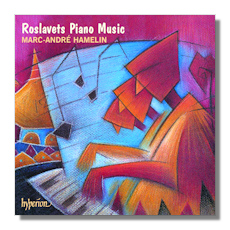
The Internet's Premier Classical Music Source
Related Links
- Latest Reviews
- More Reviews
-
By Composer
-
Collections
DVD & Blu-ray
Books
Concert Reviews
Articles/Interviews
Software
Audio
Search Amazon
Recommended Links
Site News
 CD Review
CD Review
Nikolai Roslavets

Piano Music
- Three Compositions (1914)
- Three Études (1914)
- Piano Sonata #1 (1915)
- Prélude (1915)
- Two Compositions (1915)
- Piano Sonata #2 (1916)
- Two Poems (1920)
- Five Préludes (1919-1922)
- Piano Sonata #5 (1923)
Marc-André Hamelin, piano
Recorded in Bristol, August 1996, by Tony Faulkner, produced by Andrew Keener
Hyperion CDA66926
The music of Nikolai Roslavets (1881-1944) is heavily, almost drearily, impressionistic, drawing on the worst of both Debussy and Scriabin. Roslavets developed and followed his own opaque system of tonal organization, which was never explained to or understood by anyone, including, probably, the composer himself.
The short pieces on this disc make extensive use of the delicate washes and sweeps of tone that Debussy exploited in his well-known works. The piano is used in a similar pointillistic way to minimize its percussive character by avoiding definite rhythms and cramming odd numbers of notes into legato lines. But Roslavets' tonal sense is nothing like Debussy's. It is alien and forbidding, a sort of suprematist abstract impressionism. Expressionist music here is built with impressionist devices.
No themes are apparent here, even in the Sonatas, where some development and variations can be discerned, though I was never sure about what was being developed. The little tone poems make wonderful background music. They were not at all intrusive as long as I didn't pay attention and try to make sense of things. While at times the music shows hints of structure, it never arrives and its emotional direction and goals are generally unclear.
The Sonata #1 is a very delicate thing, constructed out of fragmentary motifs and nothing like a melody. In some places it builds in intensity, to a high pitch and density, and then leaves it hanging and returns to mid-range noodling. This has echoes of Sorabji's lush chromaticism and exotica without the passion and daring of that composer.
I would buy a disc of Hamelin playing Plastic Bertrand, and I found much to admire in his playing here. This music is in fact very complex, and in an unconventional notation. Hamelin finds his way through all of it, always in control, with the technical resources to span the range of moods. It's not his typical material, but challenging in its own peculiar way. This music has been disparaged as "etiolated Scriabin" and even Hamelin can only give us the pale pastels, and does not try to supply bright colors. This recording is valuable in that it gives us one more clue as to how Hamelin would sound playing Sorabji, something I would dearly love to hear.
The recording is clear, if somewhat reverberant, not very different from Hyperion's other studio efforts with this pianist.
For an antidote, try another Russian avant-garde composer, Alexander Mosolov, whose sonatas were written only a few years afterwards.
Copyright © 1997, Paul Geffen


















